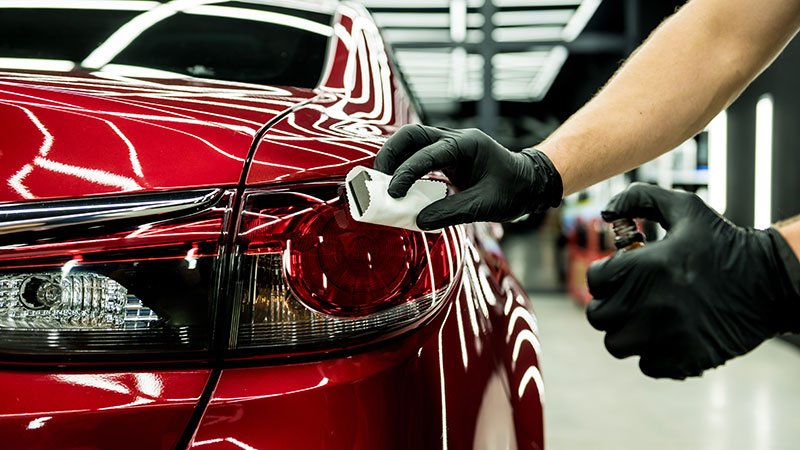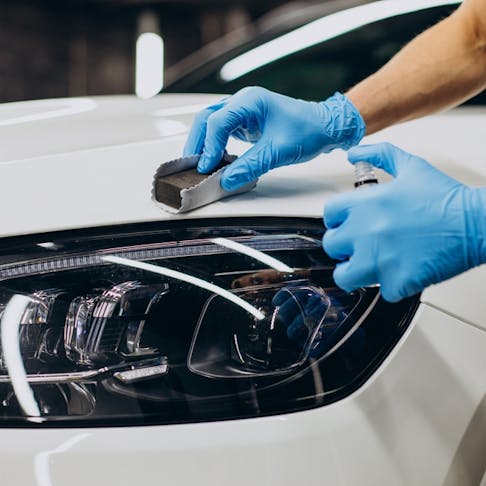Exploring the Science Behind Car Ceramic Coating and Its Safety Features
The science of car ceramic coating provides a fascinating study in sophisticated vehicle defense. Made up mostly of silicon dioxide and polymers, these coatings develop a durable bond with automobile paint. This interaction boosts resilience versus ecological dangers while supplying hydrophobic advantages. However, the complexities of just how these layers work and their long-lasting advantages continue to be much less understood. Unboxing these information exposes why ceramic finishings are ending up being a preferred option for lorry treatment
What Is Ceramic Coating?
Ceramic coating is a liquid polymer that chemically bonds to the surface area of a vehicle's paint. This advanced safety layer improves sturdiness and offers premium resistance to environmental variables. Unlike typical wax or sealers, which give momentary security, ceramic layers create a durable guard that can stand up to severe conditions such as UV rays, acidic impurities, and severe weather. When used correctly, the coating develops a hydrophobic surface, creating water to bead and slide off, which assists in preserving the lorry's cleanliness. Additionally, it uses boosted gloss and deepness to the paint, making the vehicle appear even more polished and lively. The application procedure generally entails thorough surface preparation, consisting of cleansing and sprucing up, to guarantee peak bonding. Therefore, ceramic coverings are ending up being increasingly popular among car fanatics and those seeking to safeguard their financial investments, promising to keep the vehicle's aesthetic charm while reducing the frequency of upkeep.
The Structure of Ceramic Coatings
The complex formulation of ceramic coatings mainly includes silicon dioxide (SiO2), which is stemmed from all-natural resources like quartz and sand. This crucial element supplies the foundation for the coating's durability and protective high qualities. Along with SiO2, ceramic finishes frequently include different polymers and additives that improve adhesion, flexibility, and resistance to environmental elements. These substances work synergistically to produce a durable obstacle versus contaminants such as dirt, chemicals, and UV rays.Furthermore, some formulations integrate titanium dioxide (TiO2) or other nanomaterials, which can enhance the coating's hydrophobic buildings, causing better water repellency. The accurate structure can vary greatly among manufacturers, impacting performance and long life. Inevitably, the mix of these components finishes in a safety layer that not just enhances the visual allure of automobiles however additionally serves to lengthen their life expectancy by securing the surface area from prospective damage.
Exactly How Ceramic Coatings Job
Understanding exactly how ceramic coverings function entails exploring their chemical composition, which adds to their safety qualities. The application process is important for attaining excellent outcomes, while longevity and sturdiness aspects identify the coating's efficiency over time. With each other, these aspects highlight the advantages and efficiency of ceramic coatings for car defense.
Chemical Structure Explained
While numerous car proprietors look for durable protection for their vehicles, the chemical make-up of ceramic finishes plays an essential role in their effectiveness. These layers largely include silicon dioxide (SiO2), which is stemmed from all-natural minerals. This compound creates a strong bond with the automobile's paint, producing a resilient, safety layer. Additionally, numerous ceramic coverings contain titanium dioxide (TiO2), enhancing their hydrophobic buildings and resistance to UV rays. The presence of polysiloxanes can better boost versatility and toughness. With each other, these aspects add to the coating's capability to drive away water, dust, and impurities, while also providing a high-gloss surface. Understanding this chemical structure helps car owners appreciate the durable defense used by ceramic coverings.
Application Refine Review
Applying ceramic coverings entails a precise process that assures ideal bonding and defense for the car's surface. Extensive cleaning and decontamination of the car's exterior are done to remove dust, gunk, and previous waxes. This step confirms that the surface area is cost-free from contaminations that might prevent attachment. Following this, the paint is commonly polished to improve quality and get rid of any type of blemishes. As soon as prepared, the ceramic coating is applied in little sections making use of an applicator pad, enabling for uniform protection. The coating is then delegated cure, forming a strong chemical bond with the surface. Correct healing times and problems are critical, as they confirm the coating accomplishes its optimum performance and safety qualities.
Longevity and Resilience Elements
Ceramic coverings are designed to provide resilient protection with their innovative chemical structure, which develops a robust obstacle versus environmental contaminants. The durability of these coatings is affected by variables such as the density of the application, the high quality of the item, and the problems under which the vehicle is exposed. High-grade ceramic finishings can last a number of years, withstanding scrapes, UV rays, and chemical spots. Proper upkeep, including regular cleaning and routine reapplication, can additionally enhance longevity. Furthermore, ecological elements like environment and exposure to toxins can influence the lifespan of the coating. Generally, when used and maintained correctly, ceramic layers offer extraordinary sturdiness, making them a prominent option for car fanatics seeking to maintain their vehicle's look.
Hydrophobic Residences and Water Repellency
Hydrophobic residential properties are a trademark of top quality car ceramic coverings, substantially improving the lorry's surface efficiency. These finishings develop a molecular bond with the car's paint, causing a surface that pushes back water effectively. When water enters into contact with a ceramic-coated surface, it grains up and rolls off, minimizing the amount of liquid that continues to be on the paint. This actions not only adds to a visually pleasing look yet likewise decreases the accumulation of contaminants such as dirt, gunk, and roadway salts.The enhanced water repellency results in simpler cleaning and maintenance, as less initiative is view website called for to remove unwanted compounds. Furthermore, the hydrophobic nature of ceramic coatings helps in stopping water spots, which can mar the surface of uncoated surface areas. In general, the incorporation of hydrophobic homes in ceramic coverings plays a crucial duty in keeping the lorry's immaculate appearance while simplifying maintenance.
Protection Against Scratches and UV Damage
Car ceramic finishings provide considerable protection versus scrapes and UV damage. The scratch resistance device produces a long lasting layer that absorbs effects, while the UV protecting benefits aid preserve the car's paint integrity over time. With each other, these attributes contribute to a longer-lasting and visually enticing surface.
Scratch Resistance System
Using sophisticated technology, ceramic coverings provide a durable shield versus scratches and UV damages, improving the longevity and look of car surfaces. The scrape resistance mechanism of these finishings is credited to their special molecular structure, which develops a durable bond with the lorry's paint. This bond produces a hard, safety layer that can take in influences and resist abrasions. Furthermore, the smooth surface area of the coating lowers rubbing, making it hard for pollutants to stick and trigger scrapes. The chemical composition of ceramic layers typically consists of nanoparticles that enhance the safety layer, further improving its resilience. Cars treated with ceramic finishes show noticeably boosted scrape resistance compared to typical wax or sealants, guaranteeing a beautiful finish over time.
UV Shielding Advantages
The protective qualities of ceramic coverings extend beyond scratch resistance to include significant UV shielding advantages. These layers develop a durable barrier that reflects hazardous ultraviolet rays, safeguarding the vehicle's paint and underlying products. Long term exposure to UV radiation can cause fading, oxidation, and damage of the paint finish. By incorporating ceramic coatings, car proprietors can efficiently mitigate these threats, maintaining the aesthetic appeal and honesty of their autos. Additionally, the UV obstructing residential or commercial properties contribute to boosted durability, reducing the regularity of repainting and maintenance. Inevitably, the combination of ceramic coverings uses a detailed service for protecting vehicles from the harmful impacts of sunlight direct exposure, making sure a sustained, vivid look in time.
The Durability and Upkeep of Ceramic Coatings

Frequently Asked Concerns
Can Ceramic Coating Be Applied to Any Kind Of Sort Of Lorry?
Ceramic coating can be put on different sorts of cars, including automobiles, vehicles, and bikes. However, pop over to these guys surface prep work and compatibility with specific products are crucial for perfect adhesion and performance of the coating.
Exactly How Much Does Ceramic Coating Usually Expense?
Ceramic coating typically costs in between $500 and $2,000, depending upon variables such as car size, coating high quality, and professional application. The investment can provide long-lasting protection and enhance the lorry's look in time.

Is Professional Application Needed for Ideal Results?
The need of professional application commonly depends on preferred outcomes. Specialists commonly ensure appropriate surface area preparation and application methods, resulting in excellent bonding and long life of the coating, which might be challenging for inexperienced individuals to attain.
Can Porcelain Coatings Be Removed or Repaired?
Ceramic finishes can be removed or repaired, though the process might call for particular solvents or strategies - Ceramic Coating Newark. Correct elimination is necessary to avoid damage to the underlying surface area, emphasizing the value of specialist support for excellent results
Just How Does Porcelain Coating Contrast to Typical Wax?
The contrast in between ceramic coating and conventional wax discloses that ceramic finishes offer remarkable longevity, enhanced defense versus ecological pollutants, and longer-lasting luster, find more information while wax needs much more frequent application and provides much less general resistance to damages.